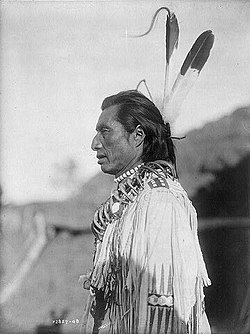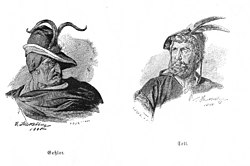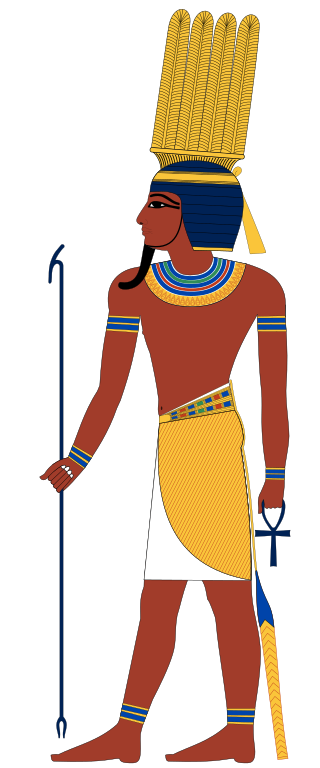
In early Egyptian mythology, Anhur was a god of war who was worshipped in the Egyptian area of Abydos, and particularly in Thinis. Myths told that he had brought his wife, Mehit, who was his female counterpart, from Nubia, and his name reflects this—it means '(one who) leads back the distant one'.

The Blackfoot Confederacy, Niitsitapi, or Siksikaitsitapi, is a historic collective name for linguistically related groups that make up the Blackfoot or Blackfeet people: the Siksika ("Blackfoot"), the Kainai or Blood, and two sections of the Peigan or Piikani – the Northern Piikani (Aapátohsipikáni) and the Southern Piikani. Broader definitions include groups such as the Tsúùtínà (Sarcee) and A'aninin who spoke quite different languages but allied with or joined the Blackfoot Confederacy.

A hat is a head covering which is worn for various reasons, including protection against weather conditions, ceremonial reasons such as university graduation, religious reasons, safety, or as a fashion accessory. Hats which incorporate mechanical features, such as visors, spikes, flaps, braces or beer holders shade into the broader category of headgear.

Bonnet has been used as the name for a wide variety of headgear for both sexes—more often female—from the Middle Ages to the present. As with "hat" and "cap", it is impossible to generalize as to the styles for which the word has been used, but there is for both sexes a tendency to use the word for styles in soft material and lacking a brim, or at least one all the way round, rather than just at the front. Yet the term has also been used, for example, for steel helmets. This was from Scotland, where the term has long been especially popular.

The mohawk is a hairstyle in which, in the most common variety, both sides of the head are shaven, leaving a strip of noticeably longer hair in the center. Mohawk hairstyles have existed for thousands of years. As of the 21st century, they are most commonly associated with punks, or broader non-conformity.

A bearskin is a tall fur cap derived from mitre caps worn by grenadier units in the 17th and 18th centuries. Initially worn by only grenadiers, its usage was extended to several other military units in the 19th century. The bearskin cap continued to see use in battle during the mid-19th century, although by the 20th century, its use was limited as a headgear reserved for parade dress. In the 21st century, the bearskin cap is retained by select military units as a prominent element of their ceremonial and full dress uniforms.
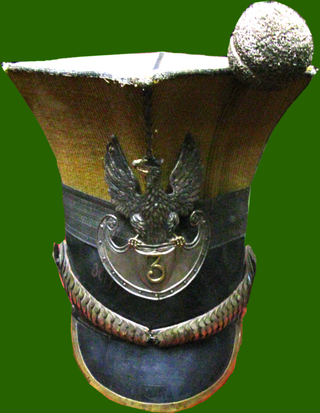
Czapka is a Polish, Belarusian, and Russian generic word for a cap. However, it is perhaps best known to English speakers as a word for the 19th-century Polish cavalry headgear, consisting of a high, four-pointed cap with regimental insignia on the front to which feathers or rosettes were sometimes added.

War bonnets are feathered headgear traditionally worn by male leaders of the American Plains Indians Nations who have earned a place of great respect in their tribe. Originally they were sometimes worn into battle, but they are now primarily used for ceremonial occasions. In the Native American and First Nations communities that traditionally have these items of regalia, they are seen as items of great spiritual and political importance, only to be worn by those who have earned the right and honour through formal recognition by their people.

The hennin was a headdress in the shape of a cone, steeple, or truncated cone worn in the Late Middle Ages by European women of the nobility. They were most common in Burgundy and France, but also elsewhere, especially at the English courts, and in Northern Europe, Hungary and Poland. They were little seen in Italy. It is unclear what styles the word hennin described at the time, though it is recorded as being used in French areas in 1428, probably before the conical style appeared. The word does not appear in English until the 19th century. The term is therefore used by some writers on costume for other female head-dresses of the period. This headgear was inspired by the headgear then current in the Mongol court.
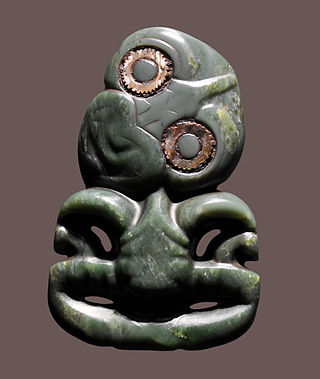
Jewellery making in the Pacific started later than in other areas, due to relatively recent human settlement. Early Polynesian jewellery, which was made of bone, wood and other natural materials, has not survived. The precise start of island jewellery-making is difficult to pinpoint, due to many of the island nations' founders migrating there from other areas, such as Tahiti.

Kurgan stelae or Balbals are anthropomorphic stone stelae, images cut from stone, installed atop, within or around kurgans, in kurgan cemeteries, or in a double line extending from a kurgan. The stelae are also described as "obelisks" or "statue menhirs".

The feather bonnet is a type of military headdress used mainly by the Scottish Highland infantry regiments of the British Army from about 1763 until the outbreak of World War I. It is now mostly worn by pipers and drummers in various bands throughout the world. It is also worn in a similar fashion by regiments in various Commonwealth armies.

Paraguayan Indigenous art is the visual art created by the indigenous peoples of Paraguay. While indigenous artists embrace contemporary Western art media, their arts also include pre-Columbian art forms. Indigenous art includes ceramics, baskets, weaving and threading, feather art and leather work. It is a hybrid nature includes the embroideries, lace, woodcarving and different metal products. Paraguay is particularly known for its indigenous featherwork and basket weaving.

Ekoi people, also known as Ejagham, are an ethnic group in southeastern Nigeria and extending eastward into the southwest region of Cameroon. They speak the Ejagham language. Other Ekoi languages are spoken by related groups, including the Etung, some groups in Ikom, some groups in Ogoja, Ufia, and Yakö. The Ekoi have lived closely with the nearby Efik, Annang, Ibibio, and Igbo people of southeastern Nigeria. The Ekoi are best known for their Ekpe headdresses and the Nsibidi text. Whereas the Igbos are the creators of the Nsibidi ideograms, the Ekoi, like other peoples from the old Cross River region still use them as a part of tradition.
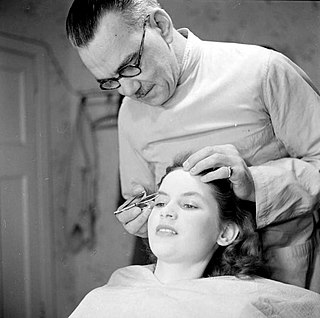
Plucking or tweezing can mean the process of human hair removal, removing animal hair or a bird's feathers by mechanically pulling the item from the owner's body. In humans, hair removal is done for personal grooming purposes, usually with tweezers. An epilator is a motorised hair plucker. Those under the influence of deliriants or trichotillomania may pluck their own hair out of habit.

Headgear, headwear, or headdress is any element of clothing which is worn on one's head, including hats, helmets, turbans and many other types. Headgear is worn for many purposes, including protection against the elements, decoration, or for religious or cultural reasons, including social conventions.
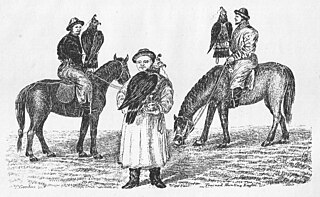
Mankind has been fascinated by the golden eagle as early as the beginning of recorded history. Most early-recorded cultures regarded the golden eagle with reverence. Only after the Industrial Revolution, when sport-hunting became widespread and commercial stock farming became internationally common, did humans started to widely regard golden eagles as a threat to their livelihoods. This period also brought about the firearm and industrialized poisons, which made it easy for humans to kill the evasive and powerful birds. The following are various reportages of the significance of eagles, many likely pertaining to the golden eagles, in early cultures and older religions as well as national and military insignias.

A shepherd's hat is a head covering, used by a shepherd to ward off the sun and the elements. Along with a crook, it is an important tool for the shepherd.

Lingzi, also called zhiling, refers to a traditional Chinese ornament which uses long pheasant tail feather appendages to decorate some headdress in Xifu, Chinese opera costumes. In Chinese opera, the lingzi not only decorative purpose but are also used express thoughts, feelings, and the drama plot. They are typically used on the helmets of warriors, where a pair of pheasant feathers extensions are the indicators that the character is a warrior figure; the length of the feathers, on the other hand, is an indicator of the warrior's rank. The lingzi are generally about five or six feet long. Most of the time, lingzi are used to represent handsome military commanders.
